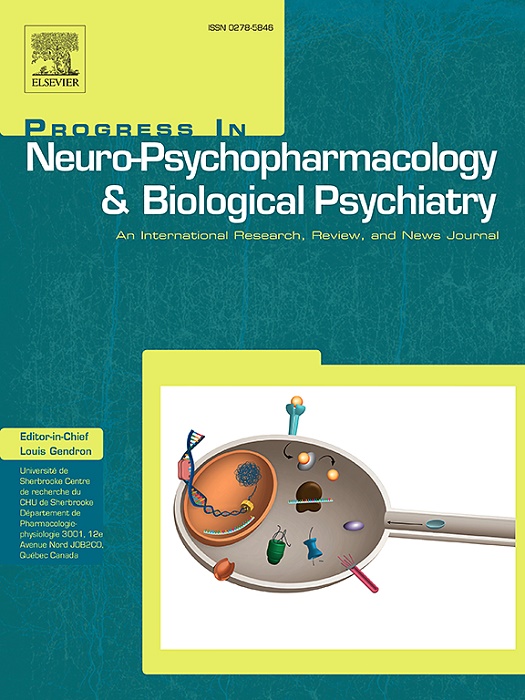Apomorphine susceptibility and prenatal infection alter neurodevelopment, synaptic density and anticipatory behavior in rats
IF 3.9
2区 医学
Q1 CLINICAL NEUROLOGY
Progress in Neuro-Psychopharmacology & Biological Psychiatry
Pub Date : 2025-09-09
DOI:10.1016/j.pnpbp.2025.111490
引用次数: 0
Abstract
Schizophrenia is a complex psychiatric disorder, driven by genetic and environmental factors. While individual risk genes have limited impact, polygenic susceptibility increases the likelihood of schizophrenia and heightens sensitivity to environmental stressors, such as prenatal immune activation. Yet, preclinical studies often focused on single-gene mutations, leaving polygenic influences largely unexplored. Using the apomorphine-susceptible (APO-SUS) rat model, which exhibits schizophrenia-like features, we investigated how polygenic susceptibility influences early neurodevelopment, synaptic density, and behavior, and how these effects are modulated by prenatal immune activation. APO-SUS rats demonstrated early neurodevelopmental abnormalities, including a reduced number and duration of separation-induced ultrasonic vocalizations (USVs), increased principal frequency of USVs, and reduced heart rate variability (HRV), indicative of heightened sympathetic dominance commonly seen in psychiatric disorders. These effects were particularly pronounced in females. Male APO-SUS rats exhibited elevated synaptophysin levels, a presynaptic marker for synaptic density, in the frontal cortex during adolescence and in the hippocampus during adulthood. Interestingly, prenatal immune activation counteracted some of these changes, preventing HRV reduction and normalizing synaptophysin levels. Male and female APO-SUS rats, as well as Wistar male rats exposed to prenatal immune activation, showed anticipatory behavior during adolescence, but not in adulthood. Our results suggest that polygenic susceptibility induces early neurodevelopmental changes and that genetic and environmental risk factors do not always act synergistically; sometimes counterbalancing each other. Future studies should explore how early neurodevelopmental changes, such as alterations in USVs and HRV, influence later behavioral outcomes in polygenic models of schizophrenia.
阿波啡易感性和产前感染改变大鼠神经发育、突触密度和预期行为
精神分裂症是一种复杂的精神疾病,由遗传和环境因素驱动。虽然个体风险基因的影响有限,但多基因易感性增加了精神分裂症的可能性,并增加了对环境压力源(如产前免疫激活)的敏感性。然而,临床前研究往往集中在单基因突变上,而多基因的影响在很大程度上未被探索。我们利用表现出精神分裂症样特征的阿吗啡易感(APO-SUS)大鼠模型,研究了多基因易感性如何影响早期神经发育、突触密度和行为,以及这些影响如何通过产前免疫激活来调节。APO-SUS大鼠表现出早期神经发育异常,包括分离诱导的超声发声(usv)次数和持续时间减少,usv主频率增加,心率变异性(HRV)降低,这表明在精神疾病中常见的交感优势增强。这些影响在女性身上尤为明显。雄性APO-SUS大鼠在青春期的额叶皮质和成年期的海马体中表现出突触素水平升高,突触素是突触密度的突触前标记物。有趣的是,产前免疫激活抵消了这些变化,阻止了HRV的降低并使突触素水平正常化。雄性和雌性APO-SUS大鼠,以及Wistar雄性大鼠暴露于产前免疫激活,在青春期表现出预期行为,但在成年期没有。我们的研究结果表明,多基因易感性诱导早期神经发育变化,遗传和环境风险因素并不总是协同作用;有时会相互抵消。未来的研究应该探索早期神经发育变化,如usv和HRV的改变,如何影响多基因精神分裂症模型的后期行为结果。
本文章由计算机程序翻译,如有差异,请以英文原文为准。
求助全文
约1分钟内获得全文
求助全文
来源期刊
CiteScore
12.00
自引率
1.80%
发文量
153
审稿时长
56 days
期刊介绍:
Progress in Neuro-Psychopharmacology & Biological Psychiatry is an international and multidisciplinary journal which aims to ensure the rapid publication of authoritative reviews and research papers dealing with experimental and clinical aspects of neuro-psychopharmacology and biological psychiatry. Issues of the journal are regularly devoted wholly in or in part to a topical subject.
Progress in Neuro-Psychopharmacology & Biological Psychiatry does not publish work on the actions of biological extracts unless the pharmacological active molecular substrate and/or specific receptor binding properties of the extract compounds are elucidated.

 求助内容:
求助内容: 应助结果提醒方式:
应助结果提醒方式:


